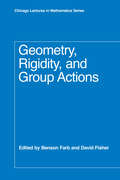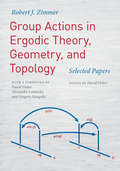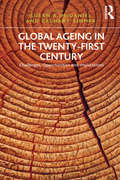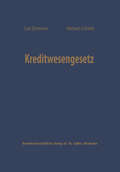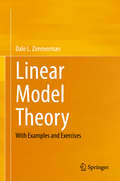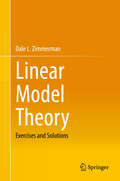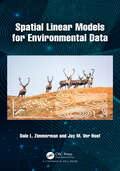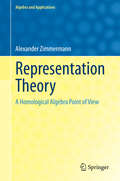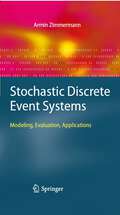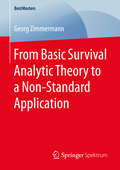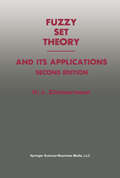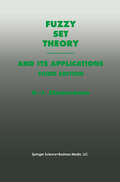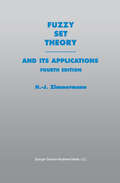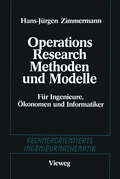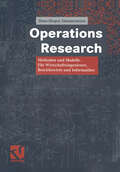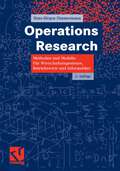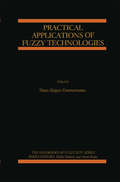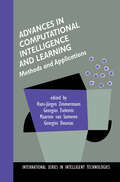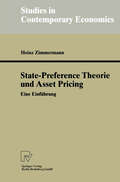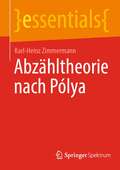- Table View
- List View
Geometry, Rigidity, and Group Actions (Chicago Lectures in Mathematics)
by Robert J ZimmerThe study of group actions is more than a hundred years old but remains to this day a vibrant and widely studied topic in a variety of mathematic fields. A central development in the last fifty years is the phenomenon of rigidity, whereby one can classify actions of certain groups, such as lattices in semi-simple Lie groups. This provides a way to classify all possible symmetries of important spaces and all spaces admitting given symmetries. Paradigmatic results can be found in the seminal work of George Mostow, Gergory Margulis, and Robert J. Zimmer, among others. The papers in Geometry, Rigidity, and Group Actions explore the role of group actions and rigidity in several areas of mathematics, including ergodic theory, dynamics, geometry, topology, and the algebraic properties of representation varieties. In some cases, the dynamics of the possible group actions are the principal focus of inquiry. In other cases, the dynamics of group actions are a tool for proving theorems about algebra, geometry, or topology. This volume contains surveys of some of the main directions in the field, as well as research articles on topics of current interest.
Group Actions in Ergodic Theory, Geometry, and Topology: Selected Papers
by Robert J. ZimmerRobert J. Zimmer is best known in mathematics for the highly influential conjectures and program that bear his name. Group Actions in Ergodic Theory, Geometry, and Topology: Selected Papers brings together some of the most significant writings by Zimmer, which lay out his program and contextualize his work over the course of his career. Zimmer’s body of work is remarkable in that it involves methods from a variety of mathematical disciplines, such as Lie theory, differential geometry, ergodic theory and dynamical systems, arithmetic groups, and topology, and at the same time offers a unifying perspective. After arriving at the University of Chicago in 1977, Zimmer extended his earlier research on ergodic group actions to prove his cocycle superrigidity theorem which proved to be a pivotal point in articulating and developing his program. Zimmer’s ideas opened the door to many others, and they continue to be actively employed in many domains related to group actions in ergodic theory, geometry, and topology. In addition to the selected papers themselves, this volume opens with a foreword by David Fisher, Alexander Lubotzky, and Gregory Margulis, as well as a substantial introductory essay by Zimmer recounting the course of his career in mathematics. The volume closes with an afterword by Fisher on the most recent developments around the Zimmer program.
Group Actions in Ergodic Theory, Geometry, and Topology: Selected Papers
by Robert J. ZimmerRobert J. Zimmer is best known in mathematics for the highly influential conjectures and program that bear his name. Group Actions in Ergodic Theory, Geometry, and Topology: Selected Papers brings together some of the most significant writings by Zimmer, which lay out his program and contextualize his work over the course of his career. Zimmer’s body of work is remarkable in that it involves methods from a variety of mathematical disciplines, such as Lie theory, differential geometry, ergodic theory and dynamical systems, arithmetic groups, and topology, and at the same time offers a unifying perspective. After arriving at the University of Chicago in 1977, Zimmer extended his earlier research on ergodic group actions to prove his cocycle superrigidity theorem which proved to be a pivotal point in articulating and developing his program. Zimmer’s ideas opened the door to many others, and they continue to be actively employed in many domains related to group actions in ergodic theory, geometry, and topology. In addition to the selected papers themselves, this volume opens with a foreword by David Fisher, Alexander Lubotzky, and Gregory Margulis, as well as a substantial introductory essay by Zimmer recounting the course of his career in mathematics. The volume closes with an afterword by Fisher on the most recent developments around the Zimmer program.
Group Actions in Ergodic Theory, Geometry, and Topology: Selected Papers
by Robert J. ZimmerRobert J. Zimmer is best known in mathematics for the highly influential conjectures and program that bear his name. Group Actions in Ergodic Theory, Geometry, and Topology: Selected Papers brings together some of the most significant writings by Zimmer, which lay out his program and contextualize his work over the course of his career. Zimmer’s body of work is remarkable in that it involves methods from a variety of mathematical disciplines, such as Lie theory, differential geometry, ergodic theory and dynamical systems, arithmetic groups, and topology, and at the same time offers a unifying perspective. After arriving at the University of Chicago in 1977, Zimmer extended his earlier research on ergodic group actions to prove his cocycle superrigidity theorem which proved to be a pivotal point in articulating and developing his program. Zimmer’s ideas opened the door to many others, and they continue to be actively employed in many domains related to group actions in ergodic theory, geometry, and topology. In addition to the selected papers themselves, this volume opens with a foreword by David Fisher, Alexander Lubotzky, and Gregory Margulis, as well as a substantial introductory essay by Zimmer recounting the course of his career in mathematics. The volume closes with an afterword by Fisher on the most recent developments around the Zimmer program.
Global Ageing in the Twenty-First Century: Challenges, Opportunities and Implications
by Zachary ZimmerPopulation ageing - a growth in the proportion of a population that is in older age - is now occurring in every region and nearly every country of the world. Indeed, the growth of older populations is among the important global phenomena of the twenty-first century. It poses both opportunities and challenges for societies and policy makers, but these are far from uniform worldwide. Dynamic factors are at work impacting on how ageing will influence people, places and policies and there are large variations in the rate and timing of population ageing across countries, owing to differing social, health and economic circumstances and a variety of policy options from which to choose. Given this variation in the context of global ageing as a backdrop, this edited book focuses on three overarching themes that are among the most critical to understand if societies are to age successfully in the twenty-first century and beyond: Healthy ageing and health care; the ageing workforce, retirement and the provision of pensions; shifting intergenerational relations. These three themes are cross-cut by other dimensions that are intertwined with the dynamic processes of ageing, such as immigration/emigration, contrasting policy regimes and global and national economic forces. This ground-breaking book will be of interest to all scholars, students and policy-makers working within this area of study.
Global Ageing in the Twenty-First Century: Challenges, Opportunities and Implications
by Zachary ZimmerPopulation ageing - a growth in the proportion of a population that is in older age - is now occurring in every region and nearly every country of the world. Indeed, the growth of older populations is among the important global phenomena of the twenty-first century. It poses both opportunities and challenges for societies and policy makers, but these are far from uniform worldwide. Dynamic factors are at work impacting on how ageing will influence people, places and policies and there are large variations in the rate and timing of population ageing across countries, owing to differing social, health and economic circumstances and a variety of policy options from which to choose. Given this variation in the context of global ageing as a backdrop, this edited book focuses on three overarching themes that are among the most critical to understand if societies are to age successfully in the twenty-first century and beyond: Healthy ageing and health care; the ageing workforce, retirement and the provision of pensions; shifting intergenerational relations. These three themes are cross-cut by other dimensions that are intertwined with the dynamic processes of ageing, such as immigration/emigration, contrasting policy regimes and global and national economic forces. This ground-breaking book will be of interest to all scholars, students and policy-makers working within this area of study.
Kreditwesengesetz: Systematische Einführung und Kommentar
by Carl ZimmererMit dem neuen Gesetz über das Kreditwesen vom 10. Juli 1961, das am 1. Januar 1962 in Kraft tritt, ist der unbefriedigende und zum Teil unklare Rechtszustand, der seit Kriegsende auf dem Gebiete des Kreditwesens herrschte, beseitigt worden. Die interessierten Kreise halten das neue Kredit wesengesetz für eine abgewogene Grundsatzgesetzgebung, die die im öffent lichen Interesse erforderliche Einflußnahme des Staates auf die Tätigkeit der Kreditinstitute ohne störende Eingriffe in deren Geschäftspolitik gewähr leistet. Das Gesetz vermeidet in gleicher Weise die Lücken eines Rahmen gesetzes wie die Gefahren eines perfektionistischen Gesetzes. Es wird auf un absehbare Zeit die maßgebliche Rechtsgrundlage für die Beurteilung öffent lich-rechtlicher und privatrechtlicher Fragen der Kreditwirtschaft sein. Zur Erläuterung der Zielsetzung und der Anforderungen des neuen Gesetzes haben es zwei Autoren, die beide den Ruf erster Fachleute für sich in An spruch nehmen dürfen, unternommen, eine systematische Einführung und einen Kommentar zu verfassen. Dr. earl Zimmerer, früher Direktor einer Großbank, seit einigen Jahren geschäftsführender Gesellschafter einer Finan zierungsgesellschaft, schrieb die systematische Einführung und legte dabei vor allem Wert auf die Änderungen, die das Gesetz im Vergleich zum bisher geltenden Recht mit sich brachte. Dr. Herbert Schönle, ao. Professor für deutsches Zivil-, Handels-und Wirtschaftsrecht an der Universität Genf, kom mentierte die Normen des Gesetzes im einzelnen.
Linear Model Theory: With Examples and Exercises
by Dale L. ZimmermanThis textbook presents a unified and rigorous approach to best linear unbiased estimation and prediction of parameters and random quantities in linear models, as well as other theory upon which much of the statistical methodology associated with linear models is based. The single most unique feature of the book is that each major concept or result is illustrated with one or more concrete examples or special cases. Commonly used methodologies based on the theory are presented in methodological interludes scattered throughout the book, along with a wealth of exercises that will benefit students and instructors alike. Generalized inverses are used throughout, so that the model matrix and various other matrices are not required to have full rank. Considerably more emphasis is given to estimability, partitioned analyses of variance, constrained least squares, effects of model misspecification, and most especially prediction than in many other textbooks on linear models. This book is intended for master and PhD students with a basic grasp of statistical theory, matrix algebra and applied regression analysis, and for instructors of linear models courses. Solutions to the book’s exercises are available in the companion volume Linear Model Theory - Exercises and Solutions by the same author.
Linear Model Theory: Exercises and Solutions
by Dale L. ZimmermanThis book contains 296 exercises and solutions covering a wide variety of topics in linear model theory, including generalized inverses, estimability, best linear unbiased estimation and prediction, ANOVA, confidence intervals, simultaneous confidence intervals, hypothesis testing, and variance component estimation. The models covered include the Gauss-Markov and Aitken models, mixed and random effects models, and the general mixed linear model. Given its content, the book will be useful for students and instructors alike. Readers can also consult the companion textbook Linear Model Theory - With Examples and Exercises by the same author for the theory behind the exercises.
Spatial Linear Models for Environmental Data (Chapman & Hall/CRC Applied Environmental Statistics)
by Dale L. Zimmerman Jay M. Ver HoefMany applied researchers equate spatial statistics with prediction or mapping, but this book naturally extends linear models, which includes regression and ANOVA as pillars of applied statistics, to achieve a more comprehensive treatment of the analysis of spatially autocorrelated data. Spatial Linear Models for Environmental Data, aimed at students and professionals with a master’s level training in statistics, presents a unique, applied, and thorough treatment of spatial linear models within a statistics framework. Two subfields, one called geostatistics and the other called areal or lattice models, are extensively covered. Zimmerman and Ver Hoef present topics clearly, using many examples and simulation studies to illustrate ideas. By mimicking their examples and R code, readers will be able to fit spatial linear models to their data and draw proper scientific conclusions. Topics covered include: Exploratory methods for spatial data including outlier detection, (semi)variograms, Moran’s I, and Geary’s c. Ordinary and generalized least squares regression methods and their application to spatial data. Suitable parametric models for the mean and covariance structure of geostatistical and areal data. Model-fitting, including inference methods for explanatory variables and likelihood-based methods for covariance parameters. Practical use of spatial linear models including prediction (kriging), spatial sampling, and spatial design of experiments for solving real world problems. All concepts are introduced in a natural order and illustrated throughout the book using four datasets. All analyses, tables, and figures are completely reproducible using open-source R code provided at a GitHub site. Exercises are given at the end of each chapter, with full solutions provided on an instructor’s FTP site supplied by the publisher.
Spatial Linear Models for Environmental Data (Chapman & Hall/CRC Applied Environmental Statistics)
by Dale L. Zimmerman Jay M. Ver HoefMany applied researchers equate spatial statistics with prediction or mapping, but this book naturally extends linear models, which includes regression and ANOVA as pillars of applied statistics, to achieve a more comprehensive treatment of the analysis of spatially autocorrelated data. Spatial Linear Models for Environmental Data, aimed at students and professionals with a master’s level training in statistics, presents a unique, applied, and thorough treatment of spatial linear models within a statistics framework. Two subfields, one called geostatistics and the other called areal or lattice models, are extensively covered. Zimmerman and Ver Hoef present topics clearly, using many examples and simulation studies to illustrate ideas. By mimicking their examples and R code, readers will be able to fit spatial linear models to their data and draw proper scientific conclusions. Topics covered include: Exploratory methods for spatial data including outlier detection, (semi)variograms, Moran’s I, and Geary’s c. Ordinary and generalized least squares regression methods and their application to spatial data. Suitable parametric models for the mean and covariance structure of geostatistical and areal data. Model-fitting, including inference methods for explanatory variables and likelihood-based methods for covariance parameters. Practical use of spatial linear models including prediction (kriging), spatial sampling, and spatial design of experiments for solving real world problems. All concepts are introduced in a natural order and illustrated throughout the book using four datasets. All analyses, tables, and figures are completely reproducible using open-source R code provided at a GitHub site. Exercises are given at the end of each chapter, with full solutions provided on an instructor’s FTP site supplied by the publisher.
Representation Theory: A Homological Algebra Point of View (Algebra and Applications #19)
by Alexander ZimmermannIntroducing the representation theory of groups and finite dimensional algebras, first studying basic non-commutative ring theory, this book covers the necessary background on elementary homological algebra and representations of groups up to block theory. It further discusses vertices, defect groups, Green and Brauer correspondences and Clifford theory. Whenever possible the statements are presented in a general setting for more general algebras, such as symmetric finite dimensional algebras over a field.Then, abelian and derived categories are introduced in detail and are used to explain stable module categories, as well as derived categories and their main invariants and links between them. Group theoretical applications of these theories are given – such as the structure of blocks of cyclic defect groups – whenever appropriate. Overall, many methods from the representation theory of algebras are introduced.Representation Theory assumes only the most basic knowledge of linear algebra, groups, rings and fields and guides the reader in the use of categorical equivalences in the representation theory of groups and algebras. As the book is based on lectures, it will be accessible to any graduate student in algebra and can be used for self-study as well as for classroom use.
Stochastic Discrete Event Systems: Modeling, Evaluation, Applications
by Armin ZimmermannStochastic discrete-event systems (SDES) capture the randomness in choices due to activity delays and the probabilities of decisions. This book delivers a comprehensive overview on modeling with a quantitative evaluation of SDES. It presents an abstract model class for SDES as a pivotal unifying result and details important model classes. The book also includes nontrivial examples to explain real-world applications of SDES.
From Basic Survival Analytic Theory to a Non-Standard Application (BestMasters)
by Georg ZimmermannGeorg Zimmermann provides a mathematically rigorous treatment of basic survival analytic methods. His emphasis is also placed on various questions and problems, especially with regard to life expectancy calculations arising from a particular real-life dataset on patients with epilepsy. The author shows both the step-by-step analyses of that dataset and the theory the analyses are based on. He demonstrates that one may face serious and sometimes unexpected problems, even when conducting very basic analyses. Moreover, the reader learns that a practically relevant research question may look rather simple at first sight. Nevertheless, compared to standard textbooks, a more detailed account of the theory underlying life expectancy calculations is needed in order to provide a mathematically rigorous framework.
Produktionsplanung variantenreicher Erzeugnisse mit EDV (Betriebs- und Wirtschaftsinformatik #30)
by Gero ZimmermannDas vorliegende Buch geht schwerpunktmäßig auf die Besonderheiten der Produktionsplanung und -steuerung bei einem variantenreichen Produktspektrum ein. Die Möglichkeiten und Grenzen von strukturierten und relationalen Datenbanken zur redundanzarmen Führung der Fertigungsgrunddaten ähnlicher Erzeugnisse werden zu Beginn erörtert und Einsatzmöglichkeiten von Entscheidungstabellen und Expertensystemen aufgezeigt. Ferner werden Kriterien zur Quantifizierung der Ähnlichkeit von Varianten und Methoden zur Typenbildung und Wiederauffindung von Erzeugnissen mit vorgegebenen Merkmalen vorgestellt. Zur Prognose von Produkten mit hoher Variantenvielfalt und für Grobplanungen werden Lösungen angeboten. Da bei Varianten eine erwartungsbezogene Fertigung nur bis zu einer bestimmten Fertigungsstufe, der sogenannten Bevorratungsebene, möglich ist, werden Kriterien zur Festlegung dieser Bevorratungsebene abgeleitet und die Probleme an der Schnittstelle zwischen erwartungsbezogener und kundenauftragsbezogener Fertigung vertieft behandelt. Zum Abschluß wird eine neue sogenannte engpaßorientierte Disposition (EOD) zur Diskussion gestellt, die es erlaubt, Material- und Kapazitätsengpässe von vornherein bei der Disposition zu berücksichtigen.
Fuzzy Set Theory — and Its Applications
by Hans-Jürgen ZimmermannSince its inception 20 years ago the theory of fuzzy sets has advanced in a variety of ways and in many disciplines. Applications of this theory can be found in artificial intelligence, computer science, control engineering, decision theory, expert systems, logic, management science, operations research, pattern recognition, robotics and others. Theoretical advances, too, have been made in many directions, and a gap has arisen between advanced theoretical topics and applications, which often use the theory at a rather elementary level. The primary goal of this book is to close this gap - to provide a textbook for courses in fuzzy set theory and a book that can be used as an introduction. This revised book updates the research agenda, with the chapters of possibility theory, fuzzy logic and approximate reasoning, expert systems and control, decision making and fuzzy set models in operations research being restructured and rewritten. Exercises have been added to almost all chapters and a teacher's manual is available upon request.
Fuzzy Set Theory—and Its Applications
by Hans-Jürgen ZimmermannFuzzy Set Theory - And Its Applications, Third Edition is a textbook for courses in fuzzy set theory. It can also be used as an introduction to the subject. The character of a textbook is balanced with the dynamic nature of the research in the field by including many useful references to develop a deeper understanding among interested readers. The book updates the research agenda (which has witnessed profound and startling advances since its inception some 30 years ago) with chapters on possibility theory, fuzzy logic and approximate reasoning, expert systems, fuzzy control, fuzzy data analysis, decision making and fuzzy set models in operations research. All chapters have been updated. Exercises are included.
Fuzzy Set Theory—and Its Applications
by Hans-Jürgen ZimmermannThis introduction to fuzzy set theory and its multitude of applications seeks to balance the character of the book with the dynamic nature of the research. This edition includes new chapters on possibility theory, fuzzy logic and approximate reasoning, expert systems, fuzzy control, fuzzy data analysis, decision making and fuzzy set models in operations research. Existing material has been updated, and extended exercises are included.
Methoden und Modelle des Operations Research: Für Ingenieure, Ökonomen und Informatiker (Rechnerorientierte Ingenieurmathematik)
by Hans-Jürgen ZimmermannOperations Research: Methoden und Modelle. Für Wirtschaftsingenieure, Betriebswirte, Informatiker
by Hans-Jürgen ZimmermannIn diesem Buch finden Sie die Brücke zwischen klassischem Operations Research und den modernen Gebieten der Heuristik und der Theorie unscharfer Mengen. Klassische und moderne Verfahren und Modelle der Unternehmensforschung sind didaktisch geschickt dargestellt. Das Buch ist entscheidungs- und EDV-orientiert. Mit besonderen Kapiteln über Heuristiken, ganzzahlige Programmierung und die Modellierung schlecht strukturierter Systeme dient es Ihnen als modernes Lehr- und Nachschlagewerk.
Operations Research: Methoden und Modelle. Für Wirtschaftsingenieure, Betriebswirte, Informatiker
by Hans-Jürgen ZimmermannIn diesem Buch finden Sie die Brücke zwischen klassischem Operations Research und den modernen Gebieten der Heuristik und der Theorie unscharfer Mengen. Klassische und moderne Verfahren und Modelle der Unternehmensforschung sind didaktisch geschickt dargestellt. Das Buch ist entscheidungs- und EDV-orientiert. Mit besonderen Kapiteln über Heuristiken, ganzzahlige Programmierung und die Modellierung schlecht strukturierter Systeme dient es Ihnen als modernes Lehr- und Nachschlagewerk. In der Nachauflage wurde der Text durchgesehen und an einigen Stellen verbessert.
Practical Applications of Fuzzy Technologies (The Handbooks of Fuzzy Sets #6)
by Hans-Jürgen ZimmermannSince the late 1980s, a large number of very user-friendly tools for fuzzy control, fuzzy expert systems, and fuzzy data analysis have emerged. This has changed the character of this area and started the area of `fuzzy technology'. The next large step in the development occurred in 1992 when almost independently in Europe, Japan and the USA, the three areas of fuzzy technology, artificial neural nets and genetic algorithms joined forces under the title of `computational intelligence' or `soft computing'. The synergies which were possible between these three areas have been exploited very successfully. Practical Applications of Fuzzy Sets focuses on model and real applications of fuzzy sets, and is structured into four major parts: engineering and natural sciences; medicine; management; and behavioral, cognitive and social sciences. This book will be useful for practitioners of fuzzy technology, scientists and students who are looking for applications of their models and methods, for topics of their theses, and even for venture capitalists who look for attractive possibilities for investments.
Advances in Computational Intelligence and Learning: Methods and Applications (International Series in Intelligent Technologies #18)
by Hans-Jürgen Zimmermann Georgios Tselentis Maarten Van Someren Georgios DouniasAdvances in Computational Intelligence and Learning: Methods and Applications presents new developments and applications in the area of Computational Intelligence, which essentially describes methods and approaches that mimic biologically intelligent behavior in order to solve problems that have been difficult to solve by classical mathematics. Generally Fuzzy Technology, Artificial Neural Nets and Evolutionary Computing are considered to be such approaches. The Editors have assembled new contributions in the areas of fuzzy sets, neural sets and machine learning, as well as combinations of them (so called hybrid methods) in the first part of the book. The second part of the book is dedicated to applications in the areas that are considered to be most relevant to Computational Intelligence.
State-Preference Theorie und Asset Pricing: Eine Einführung (Studies in Contemporary Economics)
by Heinz ZimmermannDie State-Preference-Theorie bildet eine ideale analytische Basis zum Verständnis der ökonomischen Struktur moderner Kapitalmarktmodelle. Dieses Buch zeigt, wie ein einfaches State-Preference-Modell herangezogen werden kann, um die Bedingungen des Kapitalmarktgleichgewichts in diskreter und stetiger Zeit zu analysieren. Es handelt sich hierbei um einen einführenden Text, der zwar auf Mathematik und Statistik nicht verzichten kann, bei welchem allerdings ökonomische Überlegungen einen ebenso breiten Raum einnehmen. Das Buch schließt damit eine Lücke zwischen volkswirtschaftlichen, finanzmarkttheoretischen und auf stochastische Fragen ausgerichteten Lehrtexten.
Abzähltheorie nach Pólya (essentials)
by Karl-Heinz ZimmermannIm Zentrum dieses essentials steht der gefeierte Abzählsatz von Pólya. Damit lassen sich kombinatorische Objekte mit Symmetrien abzählen, wie etwa Halsketten mit bunten Perlen und Würfel mit gefärbten Seiten, aber auch Graphen und Bäume. Die Gruppentheorie wird dafür benutzt, die Symmetrien der abzuzählenden Figuren zu beschreiben. Darauf aufbauend kann anhand der Operation der jeweiligen Symmetriegruppe auf den gefärbten Figuren die Anzahl der verschiedenen Muster ermittelt werden. Grundlegend hierfür ist das Lemma von Burnside. Aus seiner gewichteten Fassung wird unter Einbeziehung der Zyklenindexpolynome von Symmetriegruppen der berühmte Pólyasche Satz hergeleitet. Einige Beispiele runden die Darstellung ab.
